Pioneer women’s clothing represents a fascinating intersection of necessity and style. Moving westward across America in the 19th century, these women adapted the fashions of the Victorian era to the demanding realities of frontier life. While images of elaborate Victorian gowns might come to mind when thinking of the period, pioneer women’s wardrobes were a study in practicality, durability, and resourcefulness. This article explores the essential elements of Pioneer Women Clothes, revealing how they balanced fashion with the challenges of their unique environment.
Defining the Frontier Context
To understand pioneer women clothes, it’s crucial to define the “frontier” we’re discussing. This article focuses on the clothing worn by women west of the Missouri and Arkansas territories, roughly between 1850 and 1890. These were primarily the garments of homesteaders and those living in burgeoning settlement communities. While the focus is largely on white settlers migrating from the East, it’s important to acknowledge the diverse populations present on the frontier during this time.
What’s captivating about pioneer clothing is its shift in emphasis from status and wealth to communal spirit and the shared experience of pursuing dreams in uncharted territories. Clothing became less about displaying social standing and more about functionality and shared identity in the face of new beginnings.
The Foundation: Undergarments
Interestingly, the underpinnings of pioneer women clothes weren’t drastically different from those worn in Eastern cities. The chemise remained a fundamental garment – a light cotton slip worn next to the skin for hygiene and frequent washing. Pantalets, made of flannel or cotton, were layered over the chemise for modesty, serving as a precursor to modern underwear.
Contrary to initial assumptions, corsets were a common element of pioneer women clothes. Many women venturing west were driven by aspirations for a better future, rooted in strong values and a desire to maintain societal norms. For these “proper” and proud women, forgoing a corset, a garment considered essential at the time, was not an option.
While the rigors of daily labor might have led some women to loosen or temporarily abandon their corsets during strenuous tasks, the majority of pioneer women brought corsets with them and wore them whenever feasible.
Following the corset, petticoats were added, often multiple layers depending on the weather, formality of the occasion, or the desired fullness of the skirt. Stockings were a constant when leaving the house or receiving guests, typically held up with garters or tucked into pantalets – a method that indeed sounds rather uncomfortable by today’s standards.
Fabrics of the Frontier
Calico emerged as the quintessential fabric for pioneer women clothes. Often associated with quaint floral prints, calico is actually a type of plain-woven cotton fabric, slightly lighter than modern canvas. Its characteristics made it ideal for the frontier environment: lightweight, durable, and easily cleaned. General stores offered calico in various dyed options, or women would dye it themselves using commercially available dyes or natural pigments derived from plants like leaves, bark, berries, and fruits.
For “Sunday best” and more formal attire, cotton and silk fabrics were still utilized. Pioneer women often brought a few finer dresses with them from the East for special occasions.
While general stores became sources for fabrics, accessibility varied greatly depending on location and proximity to settlements. In more remote areas, families often relied on homespun fabrics, a topic that warrants its own dedicated exploration.
Everyday Pioneer Women Clothes: Practicality Meets Style
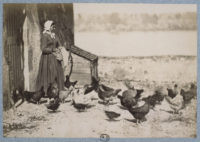
Regardless of their backgrounds, pioneer women in frontier settlements were integral to establishing and maintaining households and farms. Their days were filled with cooking, cleaning, childcare, laundry, and often, fieldwork. The success of family farms and ventures relied heavily on the physical contributions of every member, with no room for outsourcing domestic labor. Pioneer women quickly adapted to a life of manual labor, and their clothing reflected this reality.
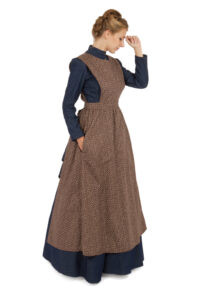
Pioneer Calico Apron
The prevailing dress styles of the era – fitted bodices and full skirts – were adopted into pioneer women clothes, but with practical modifications. Skirts for everyday wear were hemmed approximately three inches shorter to facilitate movement and daily tasks. Weights were sometimes sewn into the hems to prevent skirts from blowing up in the wind and revealing too much leg, a concern for modesty and practicality in windy frontier conditions.
Bodices remained fitted, but sleeves were loosened and extended to the wrists, paired with high collars to shield against the sun’s harsh rays. These adaptations prioritized protection and freedom of movement while retaining the silhouette of the time.
Laundry was a significant undertaking for pioneer women. An intriguing reference to “wash dresses” appears in Chris Enss’s book, How the West Was Worn. These dresses, made of two-piece white cotton with printed backgrounds, gained popularity around 1867 for their easy care. Sold in stores and replicated by seamstresses, “wash dresses” were practical garments worn across socioeconomic lines, highlighting the frontier’s influence on fashion innovation driven by necessity.
Sunday Best: Church and Community
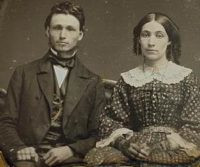
Even in sparsely populated frontier settlements, churches were often central to community life, and attending services was generally expected. While accounts exist of women in impoverished communities arriving barefoot to church, it was more common for pioneer women to possess a dress or two specifically reserved for Sundays. However, historical records tend to focus on more privileged settlers, making it challenging to definitively ascertain the most prevalent reality.
“Sunday best” pioneer women clothes closely mirrored contemporary fashions in Eastern cities. Full skirts, petticoats, and corsets remained essential. Sleeves during this period featured various puffed styles like bell, leg-o’-mutton, or pagoda sleeves. Skirt styles also evolved with fashion trends, incorporating crinoline, hoop, or bustle silhouettes depending on the decade.
Color choices for Sunday dresses reflected age and marital status. Younger, newly married women favored lighter hues, transitioning to darker colors as they aged. Outfits were completed with fashionable hats, kid gloves, and low-heeled boots, demonstrating a desire to maintain social graces even in the wilderness.
Social Gatherings: Dressing for Frontier Festivities
For those with the means, pioneer women clothes included dresses designated for social events. Dances, holiday celebrations, picnics, and other community gatherings provided opportunities to socialize, and women, accustomed to dressing for occasions in the East, continued this tradition on the frontier.
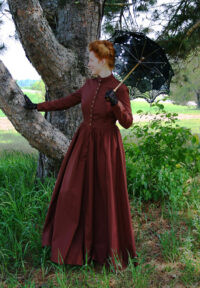
Mary Chestnut’s Americana Victorian Cotton Dress
These special occasion dresses were highly valued. Women might order fabrics from general stores and eagerly await the chance to create fashionable garments, often inspired by publications like Godey’s Ladies Book. This popular magazine circulated widely, with pioneer women sharing copies and enthusiastically replicating dress patterns and styles featured within its pages.
Fabric availability for creating new dresses depended heavily on the proximity and accessibility of general stores. In many instances, women possessed a limited wardrobe, necessitating the use of their best dress for special occasions, enhanced with accessories to elevate the ensemble. Hand-crocheted collars, shawls, and various other accessories played a crucial role in adding versatility and flair to pioneer women clothes.
Accessories: The Finishing Touches of Pioneer Women Clothes

Exploring pioneer women clothes reveals the significant role of accessories. Beyond basic garments, accessories were highly valued and considered essential for completing an outfit and expressing personal style. The emphasis on these finishing touches is evident in historical accounts, highlighting their importance in the frontier wardrobe.
Pioneer women commonly accessorized with:
- Aprons
- Boots
- Brooches
- Lockets
- Earrings
- Precious stones and metals
- Hair adornments
- Hats
- Collars and cuffs
- Gloves
- Undersleeves
- Parasols
- Fans
- Handbags
- Shawls
Legacy of Pioneer Women Clothes
The exploration of pioneer women clothes offers a glimpse into the lives of women who navigated the challenges of frontier life while striving to maintain elements of fashion and femininity. The enduring appeal of “prairie style,” “pioneer wear,” and “western wear” in contemporary fashion speaks to the lasting impact of this era. Understanding the historical context reveals how pioneer women adapted Victorian aesthetics to create a practical yet stylish wardrobe that reflected their resilience and resourcefulness.
This exploration serves as an introduction to the world of pioneer women clothes. Further investigation into specific accessories and garment details promises even richer insights into the fashion and lives of these remarkable women.
Embody the Pioneer Look:
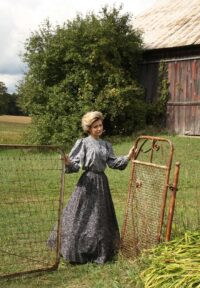 Woman in pioneer clothing standing in a field wearing a long-sleeved blue top and long blue skirt.
Woman in pioneer clothing standing in a field wearing a long-sleeved blue top and long blue skirt.
Pioneer Calico Blouse and Skirt
Explore our Pioneer Clothing Collection
Pioneer Calico Blouse and Skirt
Harper Victorian Pioneer Dress
Pioneer Blouse, Apron and Skirt Set
